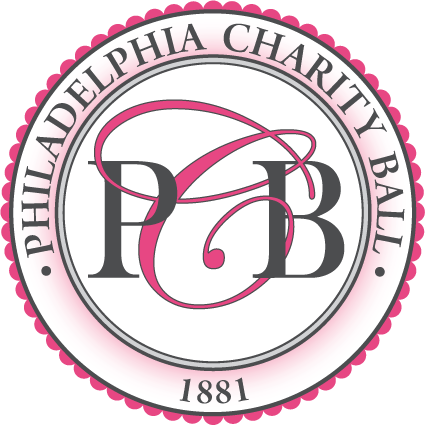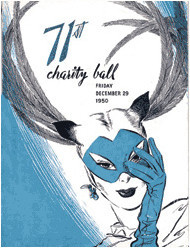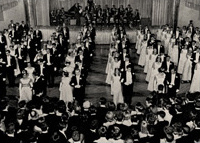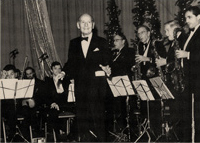
Our History
A PHILADELPHIA STORY
Over 140 Years of Charity, Excellence and tradition
“Gallants and Ladies Faire attend: A tale I bear of mirrors bright, and sounds of joy last Monday.
Strange things I’ll tell in this my ditty of what befell in Philadelphia City.” -Anonymous

It was in this spirit on February 1, 1881, that the long awaited evening of Philadelphia’s First Charity Ball occurred. Resplendent equipages crowded the front of the Academy of Music on Brad Street, and beautifully gowned ladies and their escorts in immaculate white tie ascended the stairs to the Academy.
As the guests were shown to their seats they were greeted by an unusual sight in the middle of winter—privately owned conservatories and greenhouses from across Philadelphia donated enough flowers to transform the usually austere stage of the academy into an entrancing garden of beautiful colors and sweet smells. Hyacinths, tube roses and acacias hung from the balcony. Hight above the crowd, the word “Charity” burned in gas jets.
The lights dimmed as the orchestra began the overture for its formal program, and finished half an hour later to thunderous applause. Supper included oysters, terrapin and unlimited champagne, and the cost of a single admission was five dollars. At ten o’clock the dancers took the floor, and wasn’t until three o’clock in the morning that the final strains of the orchestra died away and the doors finally closed on the last of three thousand merry makers. What was then the impressive sum of $12,597 had been raised for the The Hospital of the University of Pennsylvania, and history had been made.


The 1954 Charity Ball program cover
Colorful and entertaining traditions distinguished those balls of earlier years: they often opened with the impressive spectacle of a Grand March, and the highlight of the formal program, the Debutante Kick Chorus entailed six weeks of intensive practice of its participants.
After the rousing success of the 139th Anniversary of the Philadelphia Charity Ball, the Ball continues to grow and thrive in the 21st Century. What better place to continue the Ball’s traditions than within the walls of the historic Ballroom at the Ben.
The tradition and history that resound within this city are wonderfully exemplified by the many generations of families who have participated through their continued support of the Ball and its ideals of serving this region’s community.
About the Cotillion
A “cotte” was a short petticoat worn by country folk and the dance was so called because the ladies raised their dresses while dancing the lively figures, and thus exposed to view their feet and white petticoats.
The Cotillion was a French folk or square dance performed in the early eighteenth century. Originating in the West Indies in the early 1700s, it was refined in France in the 1750s and thus essentially became a French dance, finally arriving in England in the 1760s.
By 1844, the cotillon would be known by many as “The German” (der Kotillion). The Cotillion became popular during the reign of Charles X of France (1757-1836), and was very common in England and Scotland by the end of the 19th century.

1941 dance rehearsal with the dance master

Young ladies prepare for the Cotillion
The Presentation and Cotillion must be learned by all the Ball Participants (Debutantes, Fathers, Escorts, Young Ladies’ Committee Members, and Young Men’s Committee Members) on the morning of the Ball. The rehearsal is taught with live music to as may as 100 Participants, and the performance is learned in three hours time.
The stunning result, the beautiful fairy-tale-like spectacle seen that night is no less than a miracle. It falls upon the Dance Teacher/Choreographer, the Board of Directors, and the Managing Director to create this miracle along with the Participants.
Director William Hollenback, Jr., a committed and legendary Philadelphian, is seen with Jean Maguire as he introduces her to the crowd at a Charity Ball in the mid-90s. Mr. Hollenback died in 2002.
In this photograph taken at the Bellevue-Stratford Hotel, long the home of the PCB, young ladies and their partners take formation and face the audience composed of friends and proud families. The highlight of the evening, there are many sighs of relief when the participants can turn their energy to the party and put aside the steps and movements they had to commit to memory. Note the traditional headdresses worn by the young ladies. The Charity Ball revived this convention at its 125th Anniversary Ball in 2004.

Beloved dance mistress, Jean Maguire, is presented to guests by director William Hollenback, Jr.

The show of shows: The Cotillion
In 2004, the world mourned the loss of Lester Lanin. Philadelphia born and bred, Lester Lanin kept high society high-steppin’ in The Lanin family tradition. Not only were Lester’s grandfather and father Philadelphia bandleaders, but also six of his brothers. Known as the “Musical Maharajah of High Society,” Lester wowed Charity Ball crowds and most likely millions of others with his distinctive smooth tones, swift changes, and casually elegant style.
In a typical year, Lester employed over 1,600 musicians, playing debutante parties, wedding receptions, college proms, and Presidential Inaugurals. Mothers would book him for coming-out parties as soon as their daughters were born. He was famous for giving away multi-colored cotton hats, at the rate of 50,000 a year, with “Lester Lanin” emblazoned across the brim in script. Lester’s signature creations energized the Philadelphia Charity Ball for years, and today many of us still have his hats hanging in our closets. He will be missed.
